Hidden Cemeteries in Astoria, Queens
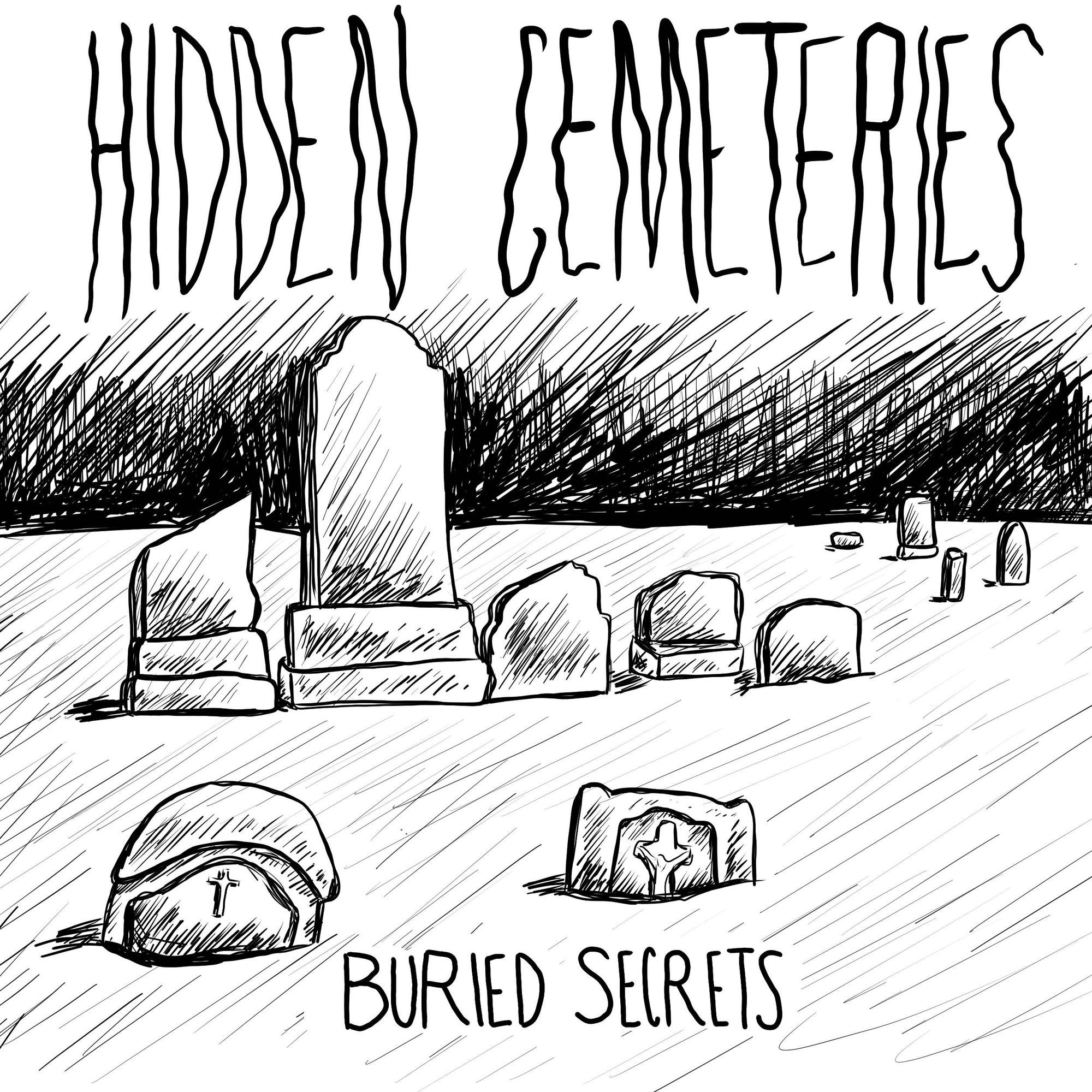
Two tiny, forgotten cemeteries sit near each other in old Astoria: one was a burying ground for the wealthy families who ran the town, and the other was for Irish immigrants who fled the famine.
Here’s a look at the history behind the graveyards, as well as a puzzling mystery about a nearby churchyard that may or may not be a burial site.
Highlights include:
• Robbers hiding their loot in a church tower
• The mystery of a man with two graves
• The discovery of human remains during a construction project
Follow the podcast on instagram @buriedsecretspodcast
E-mail the podcast at buriedsecretspodcast@gmail.com.
Pictures of hidden cemeteries in Astoria
St. George’s Church Cemetery
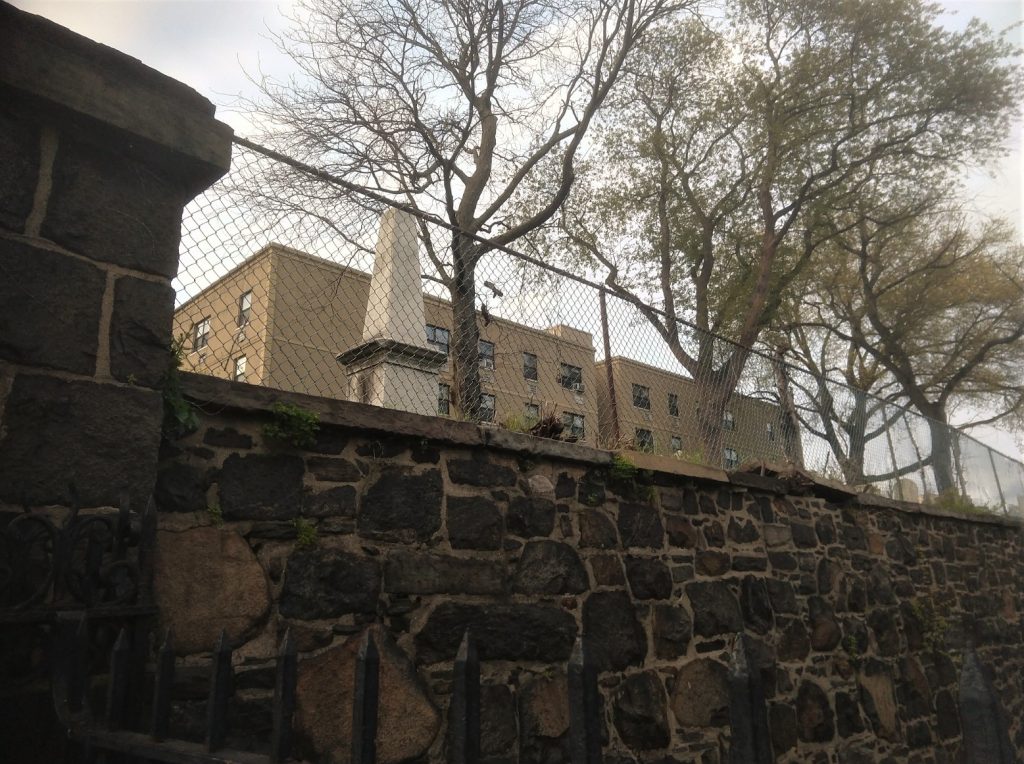
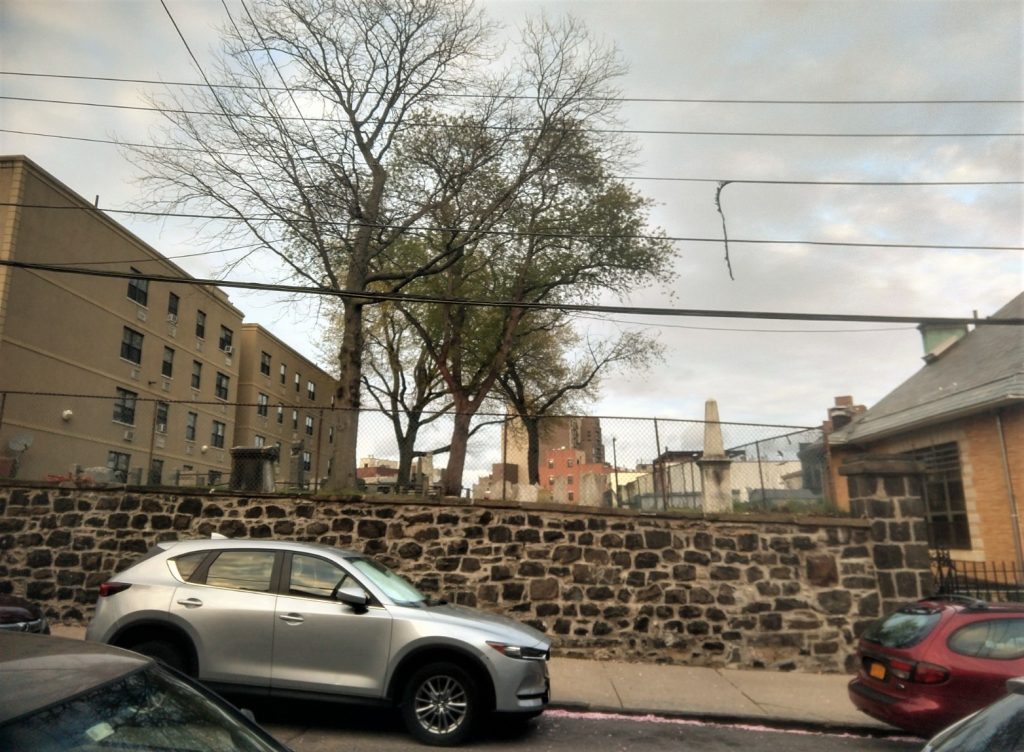
The Irish Famine Cemetery
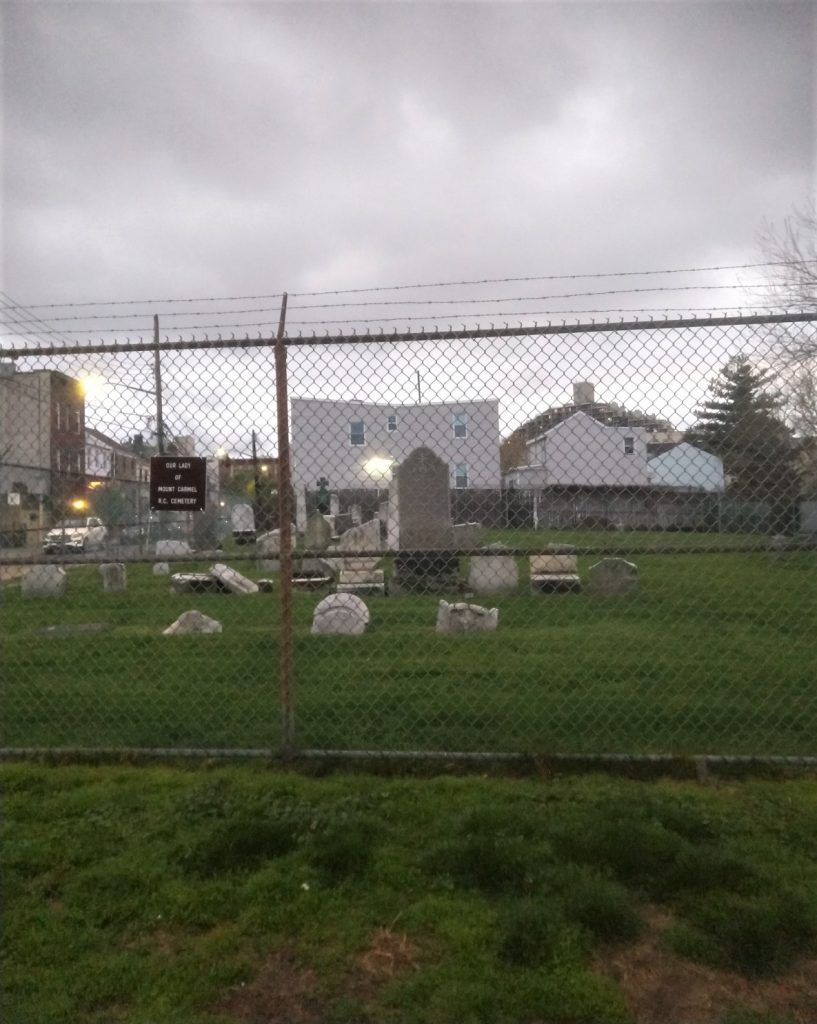
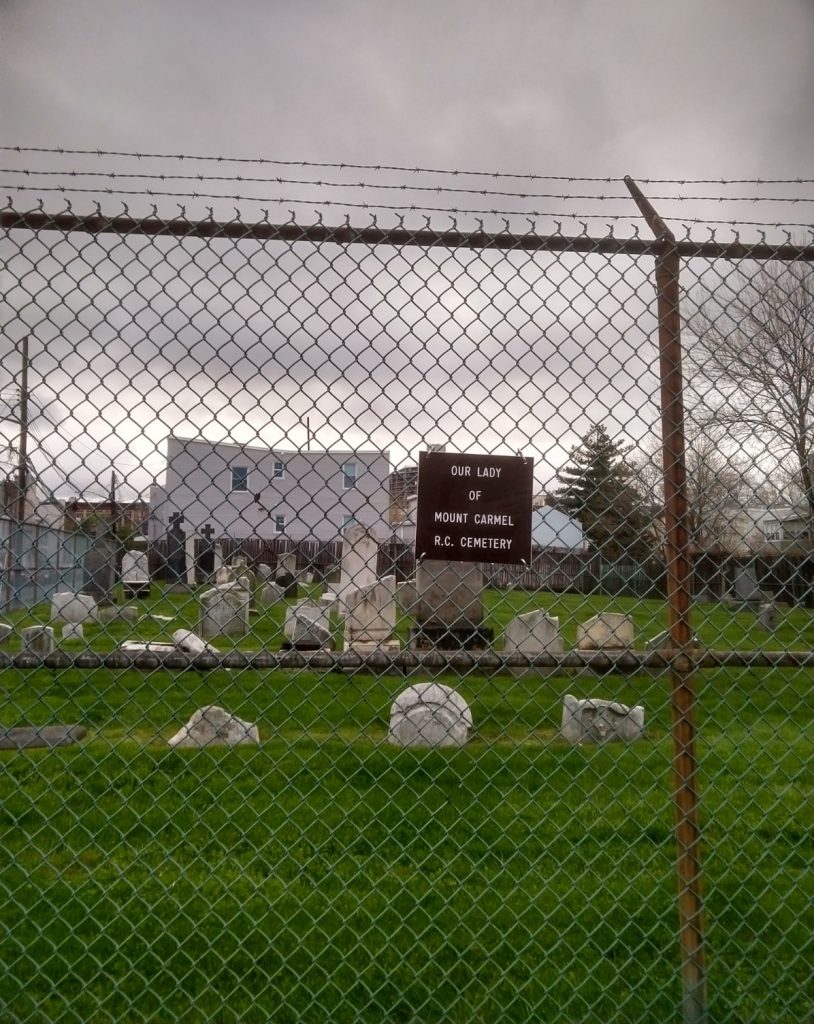
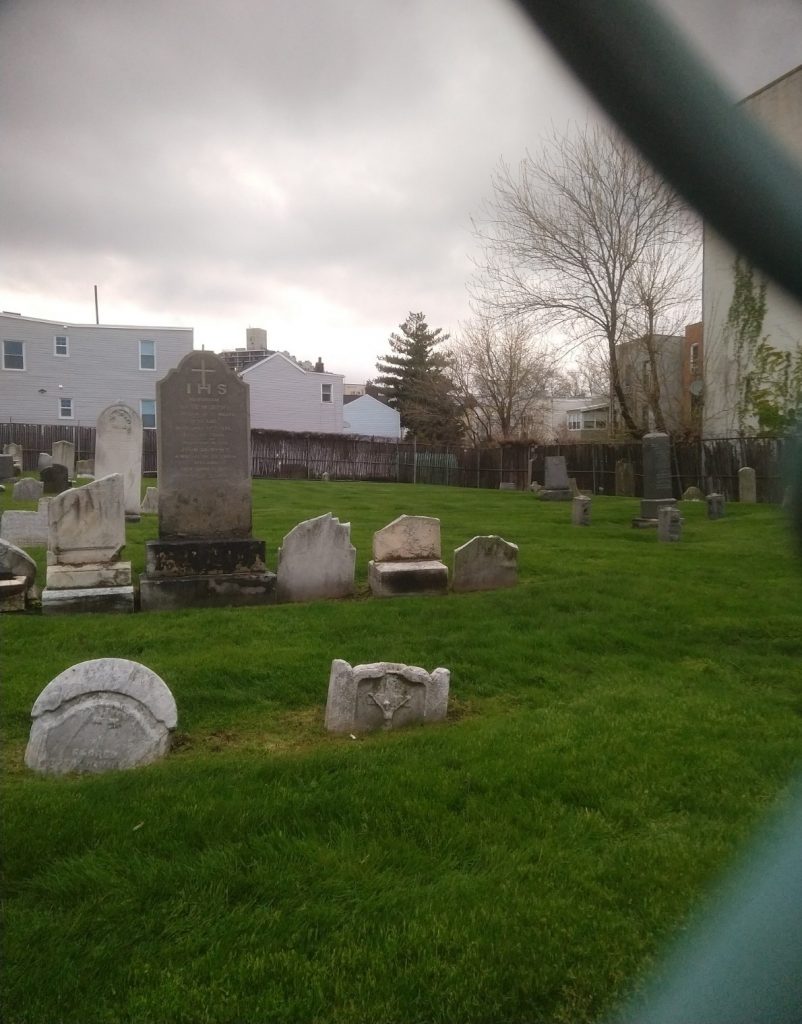
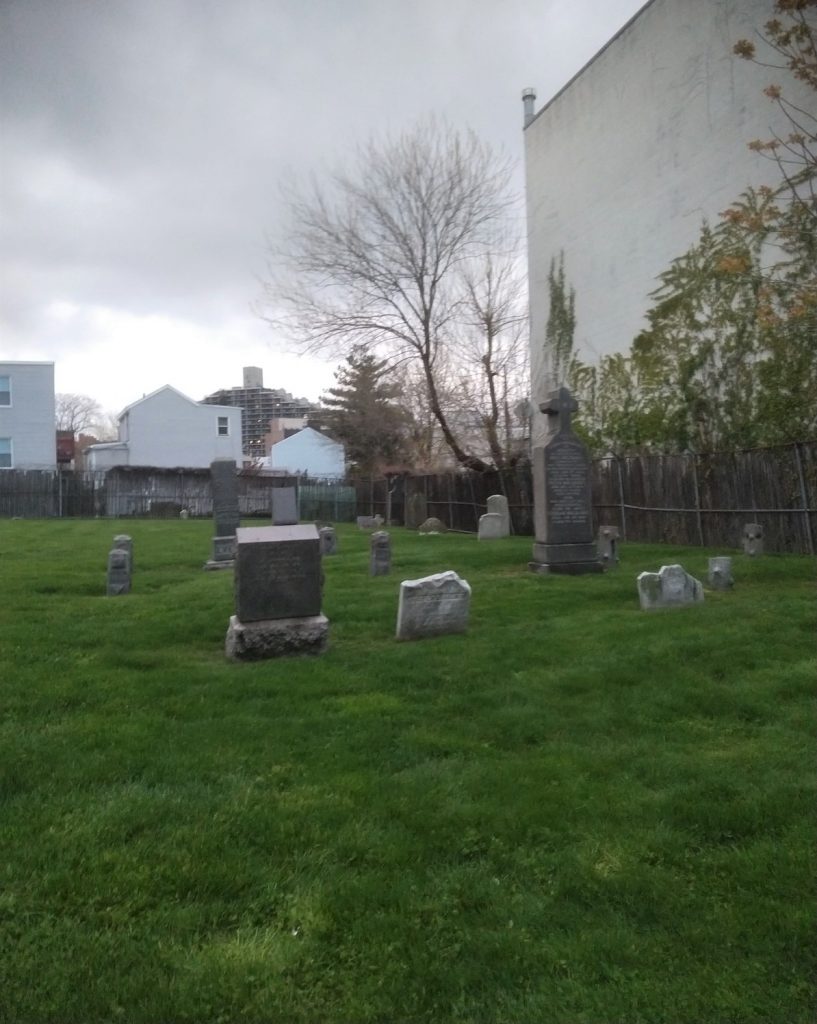
Episode Script for Hidden Cemeteries of Queens
DISCLAIMER: I’m providing this version of the script for accessibility purposes. It hasn’t been proofread, so please excuse typos. There are also some things that may differ between the final episode and this draft script. Please treat the episode audio as the final product.
- I talk a lot about Astoria, the neighborhood, or more like “town,” in Queens where I live.
- I actually have no idea how well known Astoria is outside of NYC, I’d only heard of Queens from the Ramones song We’re A Happy Family before moving to NYC.
- But you’ve almost certainly seen Astoria in TV and movies, since there’s been a big film industry presence here since the 1920s.
- I’ve talked about how I used to live right next to the big sort of film campus in the southern part of Astoria, which is made up of Kaufman Astoria Studios, the Museum of the Moving Image, and there’s also a big movie theatre over there too. Sometime I’ll do an episode about hauntings in that film complex, because there are some interesting stories over there. But basically Kaufman Astoria Studios has the biggest sound stage space than there is anywhere east of Hollywood, so a lot of stuff ends up being filmed there as well as on the streets of Astoria.
- Some films were you can see the at least some shots of the streets of Astoria include: Goodfellas and A Bronx Tale, the newest set of Spider-Man movies, as well as TV shows like Orange is the New Black and Seinfeld (George’s family home was in Astoria), though hundreds of other films were made in Astoria.
- So that’s where you may have seen or heard of Astoria.
- As for the history of colonizers in Astoria, Peter Stuyvesant, the last dutch mayor of New Amsterdam, a very bad man who I’ve talked about before, granted a man named William Hallett some land on the shore of Astoria in the mid-1600s.
- According to the 1882 book History of Queens County, the land was inhabited by the Canarsie tribe, though native-land.ca says that the Munsee Lenape and Wappinger tribes, and maybe the Matinecock, lived in the area as well. .
- History of Queens County also says that two members of the Canarsie tribe, Pomwaukon and Roweroenesteo, deeded the land to the colonizers in the area on July 9, 1666, though it doesn’t go into a lot of detail.
- At the time, the area was called Mespat or Mespachtes, according to the 1852 book The annals of Newtown, in Queens County, New York by James Riker.
- The oldest buildings in the area that are still standing are from 200 years later, in the mid-1800s. A fur merchant named Stephen Ailing Halsey incorporated the village of Astoria in 1839.
- There was a lot of argument about what the town should be called, but it ended up being named after the wealthiest man in America, John Jacob Astor.
- Like many rich people today, Astor never deined to come to Astoria, even though it was named after him. Instead, he lived in a summer mansion called Astoria, on East 87th Street in Manhattan. He could look across the river from there and see Astoria.
- There were some rich businessmen, many of whom where lumber and shipping magnates, who did move to Astoria. Their houses were built fairly near the water, in an area that’s sometimes called Astoria Village or Old Astoria now. At the time, there was a ferry that went between Astoria and Manhattan, and service to that ferry was restored a few years back, but other than the ferry, this part of Astoria isn’t particularly accessible. It’s a bit of a weird little tucked-away pocket.
- Despite having first moved to this part of Queens back in 2012 and having spent a lot of time exploring Astoria on foot, I had no idea that Old Astoria existed until last year, when I was searching for cemeteries in the area and found two in that area.
- So that brings us to our first cemetery:
St. George’s Episcopal Church Cemetery
- located in the churchyard of the historic St George’s Episcopal Church of Astoria, which I believe is the oldest church in Astoria.
- In 1825, wealthy landowner Robert Blackwell donated the land to build St. George Episcopal church. For longtime listeners, yes, this is Robert Blackwell of the Blackwell family for whom nearby Blackwell’s Island, now called Roosevelt Island, which I’ve discussed in detail in the Renwick Smallpox Hospital episodes.
- The original building, which burned down in 1894, was located at what’s now Astoria Boulevard, a few blocks away from the current structure, which was built at 27th avenue and 14 Street in 1904.
- If you go to the church’s website, it has a history section, which contains only a clipping of a January 11, 1894 NYT article titled “St. George In Ruin: Oldest Protestant Episcopal Church in Astoria Destroyed by Fire.”
- It describes how the fire started:
- “Funeral services were to have been held in the church this morning, and in order to have the edifice comfortably heated the sexton built a fire in the furnace last night. It is believed that the furnace became overheated and set fire to the woodwork.”
- There’s something a little ironic about a church burning down because of a funeral. Here’s what the article had to say about the old church:
- “It was a frame structure, and stood on high ground on the corner of Main and Woolsley Streets. It was surrounded by a spacious churchyard, containing the vaults ad graves of members of the oldest family . . . The destroyed church contained a number of marble tablets erected to the memory of some of the oldest members of the congregation and several former rectors.”
- There’s also something really strange and dark to me about the history section of an extremely historic church’s website only containing and article from the 19th century about the first version of the church being burned down.
- It describes how the fire started:
- I haven’t been inside the church, but it’s supposed to have really nice, recently restored stained glass windows.
- It sounds like in recent years, the parish has had some financial troubles, and in 2005, some of the land was leased or sold to a developer, who tore down the parish house, a historic building which had once been the Astoria Institute for the Education of Young Ladies, and replaced it with a very ugly building which seems to be a sort of nursing home or senior residence.
- The first time I went there, it was to look for the final resting place of the Blackwell family (the namesake and former owners of Blackwell’s Island, now Roosevelt Island, which I’ve talked about in past episodes.) I was rewarded with views of a beautiful church that looked to me like it’d been transported out of the English countryside.
- The Blackwells once had their own burying ground, which was in use from around 1780-1857. It was located near the water, a bit southwest of where St. George’s is. Interestingly, the location of the cemetery was immediately south of where the Roosevelt Island Bridge, which was built in the 1950s, stands now. What makes that interesting to me is that the bridge that leads to the island once named for the Blackwells is now right at the location where the Blackwells once buried their dead.
- According to The Graveyard Shift: A Family Historian’s Guide to New York City Cemeteries by Carolee Inskeep, more than 60 people were buried in the old family cemetery.
- In October 1900, the remains were moved to St. George’s Churchyard. Later, a bottle factory was built on the site, though today, the Ravenswood Generating Station, a huge power plant that was built in the 1960s, stands there today.
- About 20% of NYC’s electricity comes from that plant, and as someone who spends a decent amount of time around the area, I can tell you that it is VERY hard to breathe near that particular station, especially in the summer when the peaker is running.
- And, incidentally, the power plant was built right next to the largest public housing project in North America, the Queensbridge Houses, so all 6,000 people who live there have to breathe in the terrible air all the time.
- There’s a reason why parts of Astoria are known as asthma alley, because respiratory illnesses are more common near the power plants.
- Anyway, the Ravenswood plant stands in the Ravenswood part of Astoria, and the power plant’s plot was also the location of the Jacob Blackwell Mansion.
- For a time, a bunch of wealthy people built fancy homes in Ravenswood, though by the 1870s, the rich people moved further east into Long Island, and many of their old mansions were turned into orphanages and asylums. If that isn’t very Victorian and Gothic, idk what is.
- Incidentally, I was reading the excellent website the newtownpentacle.com, which is run by Mitch Waxman, and I wanted to read a bit from what he wrote about that area, since he happened to mention it in a blog post last week:
- “”1909 is the year that Queensboro opened for business, and that was just ten years after Queens itself was fashioned by Manhattan’s ready political hands. Then, as now, riverfront property is quite valuable. Prime industrial land was being “wasted” on the indigent and immoral, so these mansions became quite prone to grisly total loss fires. “Can’t make an omelette without breaking a few eggs” as the saying goes.””
- Incidentally, I was reading the excellent website the newtownpentacle.com, which is run by Mitch Waxman, and I wanted to read a bit from what he wrote about that area, since he happened to mention it in a blog post last week:
- Even though the remains of the Blackwells were moved from the area near the Blackwell Mansion, to St. George’s Church, I found a delightful article in the Broklyn Daily Eagle from October 5, 1900, with my favorite kind of headline: “Human Skulls Unearthed.” I read from that article in the cold open, but the article also mentioned how the property where the bottle factory was, at the time at least, known as the old Williams’ estate, but the Blackwells were buried there. They said that they’d put any other remains they found in the Blackwell family vault at St. George’s Church.
- Also, this is just to fun not to share, but the next article in the newspaper is headlined “Opossum Killed” and is about a large possum that had been eating chickens in the area of Freeport, Long Island. I found the fact that that was in the newspaper hilarious for some reason, though your mileage may vary on that.
- It looked like it constructed of rubble masonry using Fordham gneiss, had a tall tower crowned with four gargoyles, stained glass windows, and ornate doors.
- And tucked behind it was a tiny, charming churchyard cemetery.
- The graveyard was elevated by a high stone retaining wall and encircled by a chain link fence, so it was hard for me to get too close and see much of it. But by crossing the street and jumping up and down a few times, I was able to get a few glimpses of the headstones, including the large marker denoting the Blackwell family plot.
- When I went back last month, I found a small alleyway that led to another side of the cemetery, where I could see through the fence a bit better. Part of the fence is falling down, and I read somewhere that you had access to the cemetery through the alleyway, so maybe the implication is that you can climb up through the broken fence to get in?
- The Blackwell family was originally interred in the Blackwell Burial Ground in nearby Long Island City, on Vernon Boulevard about a block away from where the bridge to Roosevelt Island now stands. In 1900, their remains were relocated to this churchyard to make way for a bottle factory. The original St. George’s Church had been built on land donated by the Blackwells, so it makes sense that they would be relocated to the new location of the church when the need arose.
- I had a really wonderful time walking around the neighborhood where the church is located; despite having spent 6 years in Western Queens, I’d never ventured to this exact block, and I was charmed by the beautiful church and nearby colonial-style homes with wrought-iron gates, rustic stone walls, and creeping wisteria.
A False Graveyard–the Church of the Redeemer in Astoria
- The next cemetery I want to talk about is actually a false one.
- Around the 1860s, according to a Feb 19, 1899 article in the Sun, “trouble occurred in the congregation of St. Georges Episcopal Church . . . And a number of the influential members withdrew and organized the Church of the Redeemer. Th new congregation held services for some time in a store, but in a few years came to own a handsome stone edifice at Crescent and Temple streets.”
- For a time, there was talk of reuniting the churches, especially after St. George’s burned down, but that never happened.
- I found a really nice description of the church in a July 25, 1887 Brooklyn Daily Times article all about the different churches in the area:
- “Its architecture is early gothic, and with its solid walls clad in ivy . . . The elegant pile reminds one of what he has seen in old European towns. A young church, it already takes on an old appearance. Here many of the old Astoria families of the Episocopal church worship, but not the oldest, who are to be found at St. George’s Episcopal church.”
- I stumbled across an interesting monument that looks like a grave marker in the churchyard garden. Since there didn’t seem to be a cemetery next to the church, and I didn’t see any other grave markers, I was puzzled about what was up with this.
- I found out that a retired merchant named Cornelius Rapelye Trafford donated some money to the parish, a much-appreciated bequest since the church had money problems. According to a February 19, 1899, article in the Brooklyn Daily Eagle: “Through the death of Cornelius Rapelye Trafford, a wealthy Astorian, the church was left $10,000 for a set of chimes. The bells were purchased and placed in the church tower built for that purpose.”
- I found a bit of info about Trafford in the book History of Long Island City, New York by J. S Kelsey; 1896: He was born in 1809 and died in 1872. His father was one of the earliest colonizers to live at Halletts Cove, and the family lived at a beautiful mansion that even back then was 100 years old. Here’s a bit more about what the book has to say about him.
- “Mr. Trafford was a man of large means, which he expended liberally in the building of very many of the most attractive dwellings in different parts of Astoria and particularly on the ” Hill ” — always the aristocratic section. He was largely interested in the Astoria ferry, and aided materially in the first introduction of street cars, in fact, was to the time of his decease one of the most important factors in the community. He was noted for his geniality, and many remember with pleasure and gratitude his acts of unostentatious charity.
- “Mr. Trafford was never married, and therefore leaves no direct descendants to perpetuate the name. The beautiful chimes in the tower of the Episcopal Church of the Redeemer, on the Crescent, were given in his will by Mr. Trafford, and annually on the recurrence of his birthday, ring out sweet melodies. A massive granite cross is a striking feature on the beautiful lawn in front of the church and marks the last resting place of Mr. Trafford.”
- That last bit is really interesting, because my guess had been that it was put up as a sign of appreciation to honor the gift that Trafford made the church. I’m not totally sure which is true, though, because according to findagrave.com Trafford seems to be buried in Green-wood Cemetery in Brooklyn, a popular burial place for the wealthiest 19th century New Yorkers, alongside George R. Rapelye and his wife, Jane Maria Suydam.
-
Our Lady of Mt. Carmel Roman Catholic Cemetery
- The first time I ever visited Our Lady of Mt. Carmel Roman Catholic Cemetery was on a rainy Friday night (04/24/20., I ran to Our Lady of Mt. Carmel Roman Catholic Cemetery in Astoria, NY, also known as the Irish Famine Cemetery.
- This cemetery holds the remains of Irish immigrants who moved to Astoria in the 19th century to escape the Great Famine in Ireland.
- Between 1840-1890, about 150 people were buried here. The last burial was in 1926. All but one of them–the church’s Italian gardener–were Irish.
- Once Calvary Cemetery opened in 1848, most Catholics in Astoria, and the city in general, were buried there, which is why just a handful of people were interred in this little cemetery.
- This site was once the churchyard of Our Lady of Mt. Carmel Roman Catholic Church, back when it was called St. John’s Church. The church was founded in 1841, incidentally the same year that Fordham University was founded. The original building was a wooden frame building that sat next to the cemetery.
- As the Catholic community grew, it was expanded, and eventually they built a larger building on Newtown Avenue, a few blocks away from the cemetery, leaving this little cemetery alone on an ordinary corner of a busy street. The current church building is really beautiful and has some gothic influences, and was finished in 1873.
- Today the cemetery sits behind a chain link fence across the street from a flat tire repair shop.
- Located near Astoria Park, very close to the RFK and Hellgate Bridges.
- Even though I can’t go inside these historic places, they’re little portals to our history, and each come with their own stories and characters. So much of history feels anonymous to me: the stories we know are usually either focused on the rich and famous (and often evil) people who made a name for themselves, but we forget all of the ordinary people who came before us. That’s one thing I love about cemeteries: it adds the names of ordinary people back into our history and unconscious, even if their stories are lost.
- This cemetery was especially interesting to me because of how . . . decrepit . . . it is as a whole. So many toppled and sinking tombstones. I think this is maintained by the Archdiocese of Brooklyn, and it feels kinda forgotten.
Sources consulted RE: cemeteries in Astoria
Books
- The Graveyard Shift: A Family Historian’s Guide to New York City Cemeteries by Carolee Inskeep
- Munsell’s History of Queens County, New York, 1882
- The annals of Newtown, in Queens County, New York
by James Riker, 1852 - History of Long Island City, New York. by J. SKelsey; Long Island Star Publishing Company, 1896
- Queens Borough, New York City, 1910-1920 by Chamber of Commerce, 1920
Articles
- The Brooklyn Daily Eagle (Brooklyn, New York) · Sun, Feb 19, 1899 · Page 11
- Ancestry.com. 1870 United States Federal Census [database on-line]. Provo, UT, USA: Ancestry.com Operations, Inc., 2009. Images reproduced by FamilySearch. Year: 1870; Census Place: Astoria, Queens, New York; Roll: M593_1080; Page: 201A; Family History Library Film: 552579
- Brooklyn Times Union (Brooklyn, New York) · Sat, May 7, 1904 · Page 11 https://newscomwc.newspapers.com/image/555908491
- Brooklyn Times Union (Brooklyn, New York) · Fri, Jun 17, 1887 · Page 1 https://newscomwc.newspapers.com/image/556863449
- Brooklyn Times Union (Brooklyn, New York) · Sat, Jun 21, 1902 · Page 4 https://newscomwc.newspapers.com/image/555932624
- Brooklyn Times Union (Brooklyn, New York) · Wed, Dec 28, 1887 · Page 1 https://newscomwc.newspapers.com/image/556996064
- The Brooklyn Daily Eagle (Brooklyn, New York) · Sun, Apr 9, 1899 · Page 10 https://newscomwc.newspapers.com/image/50420388
- The Sun (New York, New York) · Sun, Feb 19, 1899 · Page 4 https://newscomwc.newspapers.com/image/79105618
- Brooklyn Times Union (Brooklyn, New York) · Mon, Nov 10, 1902 · Page 9 https://newscomwc.newspapers.com/image/555907855
- Brooklyn Evening Star (Brooklyn, New York) · Wed, Aug 13, 1862 · Page 3 https://newscomwc.newspapers.com/image/118125760
- Brooklyn Times Union (Brooklyn, New York) · Thu, Oct 15, 1903 · Page 11 https://newscomwc.newspapers.com/image/555909576
- The Brooklyn Daily Eagle (Brooklyn, New York) · Fri, Oct 5, 1900 · Page 8 https://newscomwc.newspapers.com/image/50360004
- Brooklyn Times Union (Brooklyn, New York) · Mon, Dec 5, 1887 · Page 1 https://newscomwc.newspapers.com/image/556995547
- Brooklyn Times Union (Brooklyn, New York) · Thu, Jan 29, 1891 · Page 5 https://newscomwc.newspapers.com/image/557824177
- New York Daily Herald (New York, New York) · Sat, Feb 21, 1863 · Page 5 https://newscomwc.newspapers.com/image/329273622
- Brooklyn Times Union (Brooklyn, New York) · Sat, Dec 26, 1903 · Page 14 https://newscomwc.newspapers.com/image/555934521
- The Brooklyn Daily Eagle (Brooklyn, New York) · Fri, Apr 15, 1910 · Page 6 https://newscomwc.newspapers.com/image/58335087
- Brooklyn Times Union (Brooklyn, New York) · Mon, Jul 25, 1887 · Page 1 https://newscomwc.newspapers.com/image/556992361
- Historical Archaeology of Religious Sites and Cemeteries
Author(s): Richard F. Veit, Sherene B. Baugher and Gerard P. Scharfenberger Source: Historical Archaeology , 2009, Vol. 43, No. 1, Historical Archaeology of Religious
Sites and Cemeteries (2009), pp. 1-11 Published by: Springer Stable URL: https://www.jstor.org/stable/25617539 - The Brooklyn Daily Eagle (Brooklyn, New York) · Tue, Jan 11, 1910 · Page 8 https://newscomwc.newspapers.com/image/55520065
Websites
- https://www.brownstoner.com/history/st-george-church-astoria-village/
- https://forgotten-ny.com/2020/03/van-alst-avenue-long-island-city/
- https://www.atlasobscura.com/places/irish-famine-cemetery
- https://sorabji.com/cemeteries/index/category/119-the_graveyard_of_our_lady_of_mt_carmel_church_famine_cemetery_astoria
- https://sites.rootsweb.com/~nyqueen2/cemeteries/
- https://www.findagrave.com/cemetery/1981308/our-lady-of-mount-carmel-catholic-cemetery
- http://www.nycago.org/Organs/Qns/html/OurLadyMtCarmel.html
- https://www.brownstoner.com/architecture/st-george-church-astoria-village/amp/
- https://www.archives.nyc/blog/2018/7/20/for-lo-these-many-years-forgotten-cemeteries-of-queens
- http://longislandgenealogy.com/QueensCem.pdf
- https://www.findagrave.com/memorial/141870056/cornelius-rapelye-trafford
- https://www.macaulay.cuny.edu/seminars/rosenberg09/articles/t/h/e/The_Film_Industry_in_Astoria_9fd9.html
- https://www.imdb.com/search/title/?locations=Astoria%20Studios,%20Astoria,%20Queens,%20New%20York%20City,%20New%20York,%20USA
- https://qns.com/2020/10/spider-man-comes-home-as-filming-begins-in-astoria/
- https://www.movie-locations.com/movies/s/Spider-Man-Homecoming.php
- https://forgotten-ny.com/1999/05/astoria-village-part-1-queens/
- http://www.preserve.org/gahs/histlic.htm
- https://www.tripadvisor.com/ShowUserReviews-g29837-d13998743-r574218462-St_George_s_Episcopal_Church_of_Astoria-Astoria_Queens_New_York.html
- https://www.historic-stgeorge-astoria.org/index.php/history
- http://www.interment.net/data/us/ny/queens/first-presbyterian-church-newtown.htm
- https://stmary-lic.org/
- https://www.brownstoner.com/history/queenswalk-st-marys-roman-catholic-church-in-hunters-point/
- https://en.wikipedia.org/wiki/Roosevelt_Island_Bridge
- https://en.wikipedia.org/wiki/Ravenswood_Generating_Station
- https://rihs.us/2020/11/12/thursday-november-12-2020-lets-explain-what-is-happening-in-ravenswood/
- https://en.wikipedia.org/wiki/Astoria,_Queens#Ravenswood
- https://gothamist.com/news/the-push-to-turn-nycs-polluting-peaker-plants-into-publicly-owned-solar-power
- https://www.mountcarmelastoria.org/index.php?option=com_content&view=article&id=2&Itemid=7
- https://www.mountcarmelastoria.org/index.php?option=com_content&view=article&id=31&Itemid=35
- http://www.pefagan.com/gen/queens/qmp_hal1840.htm
- https://sorabji.com/cemeteries/index/category/119-the_graveyard_of_our_lady_of_mt_carmel_church_famine_cemetery_astoria
- http://www.pefagan.com/gen/astoria/mtcarm/mtcminsc.htm
- https://newtownpentacle.com/2021/02/26/neglected-orchard/
- https://en.wikipedia.org/wiki/PS_General_Slocum
- https://forgotten-ny.com/2016/05/irish-famine-cemetery-astoria-village/
- https://www.atlasobscura.com/places/irish-famine-cemetery
- https://www.findagrave.com/cemetery/1981308/our-lady-of-mount-carmel-catholic-cemetery
Don’t miss past episodes:
- The Renwick Ruin:
- Investigating the Hawthorne Hotel:
- The Haunted Grove Park Inn, Asheville, North Carolina
- Haunted Asheville, North Carolina
- New York City Potter’s Fields
- Calvary Cemetery, Queens, New York (Part 1)
- Archbishop John Hughes, aka Dagger John: Calvary Cemetery, Queens, New York (Part 2)
- The Haunted Luxor Hotel and Casino, Las Vegas: Part 1
- The Haunted Luxor Hotel and Casino, Las Vegas: Part 2
- A Victorian Lunatic’s Fort: Fort Maxey, Blackwell’s Island, NYC
- The Roosevelt Island Lighthouse, or The Blackwell Island Light, NYC
- The General Slocum Disaster, Hell Gate, New York City
- The Haunted Hell Gate, New York City
- Haunted St. Mark’s Church-in-the-Bowery
- The New York Crystal Palace (Part 1)

